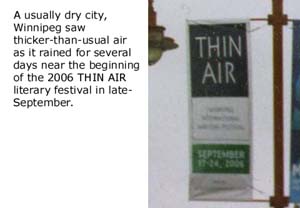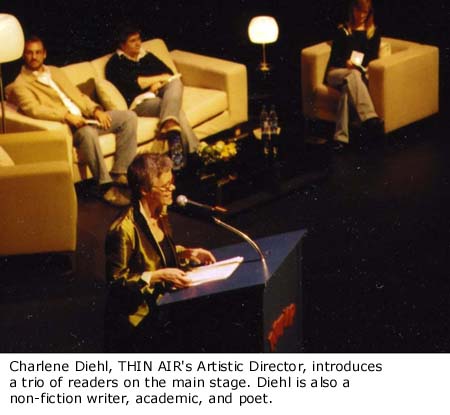|
Plains
Text: The Literary Scene in Winnipeg and Beyond
by A. J. Levin
Literature in Manitoba is
older than the province itself. Ill-fated Hudson’s Bay Company
governor Robert Semple, who met his end in what is now Winnipeg’s West
Kildonan neighbourhood, published several books at the beginning of the
19th century.
 One
of the few preconceptions outsiders have of Manitoba, and, especially,
of Winnipeg – after the visions of boring topography, blizzards,
mosquitoes, and flooding – is that of a vibrant arts scene. In part,
this is a feature of necessity, as the next sizeable community in any
direction is Minneapolis/St. Paul, hundreds of kilometres south of here.
But something in Manitobans’ temperament leads to a sort pf artistic
collectivism; perhaps it’s the long, cold winters, or perhaps the
ethnic and religious groups that make up the province. One
of the few preconceptions outsiders have of Manitoba, and, especially,
of Winnipeg – after the visions of boring topography, blizzards,
mosquitoes, and flooding – is that of a vibrant arts scene. In part,
this is a feature of necessity, as the next sizeable community in any
direction is Minneapolis/St. Paul, hundreds of kilometres south of here.
But something in Manitobans’ temperament leads to a sort pf artistic
collectivism; perhaps it’s the long, cold winters, or perhaps the
ethnic and religious groups that make up the province.
Multiculturalism here is
much older than Toronto’s vaunted mix of peoples. Even before Winnipeg
was a city, the Red River Settlement of the 19th century saw French,
Scottish, English, Swiss, Irish, Métis, Cree, Anishnawbe (Saulteaux/Ojibway),
and others living in relative harmony. Later influxes include
Icelanders, Ukrainians, Poles, Jews, Mennonites, Germans, Dutch,
Hungarians, Chinese, Portuguese, Italians, Greeks, and, since the 1970s,
Vietnamese, Filipinos, South Asians, and others. Many of these cultures
have made their mark on the literary landscape.
One of Francophone Canada’s
great writers, Gabrielle Roy, was from here, and Louis Riel was a poet
as well as a statesman. The work of French-speakers from Lower Canada
and Francophone Métis – who, until after Manitoba entered
Confederation, formed the majority here – continues. Current
Franco-Manitoban writers include J. R. Léveillé, Laurent Poliquin, and
Simone Chaput. There are several Francophone presses here, mainly
concentrating on poetry.
Aboriginal writers here
include Beatrice Culleton Mosionier and Ian Ross, also known as
"Joe from Winnipeg" (though the actor/author comes from
McCreary, a tiny community far from the provincial capital). Pemmican
Publications, which is affiliated with the Manitoba
Métis Federation, gives voice to many Aboriginal writers from
Manitoba and from farther afield.
Those of British and Irish
stock have also contributed to the literary landscape. Sinclair Ross,
Presbyterian minister Charles Gordon – who wrote under the name Ralph
Connor, Douglas Durkin (with his Norwegian-born wife, Martha Ostenso),
poet Dorothy Livesay, and, more recently, non-fiction author Jake
MacDonald and children’s writer Martha Brooks are good examples.
Americans have also influenced the province, notably poet George Amabile
and the much-admired Carol Shields, winner of a Pulitzer Prize.
Other notable writers –
John Marlin, a Hungarian; Jewish writers Adele Wiseman, famous for her
parable The Sacrifice, and storyteller Sheldon Oberman; and
Frederick Philip Grove, a German – have come from various backgrounds.
Manitoba has also produced several of the best writers in the Icelandic
language, especially poets.
Wanderers of all
backgrounds comprise a startling percentage of Manitoba writers.
Winnipeg especially functions as a vestibule for writers, some (like
Sylvia Legris, winner of the Griffin
Poetry Prize) leaving here for better things, others arriving here
– usually for a university post – and stay for anywhere from months
to several decades. Among the latter group are poets Dennis Cooley,
originally a Saskatchewanian, and Robert Kroetsch, a former Albertan.
No group, though, has been
as prominent in the province’s literature as the Anabaptist group
known as Mennonites. Sci-fi author A. E. van Vogt, humorists Paul
Hiebert and Armin Wiebe, Giller-winning
novelist David Bergen, Governor
General’s Award–winner Miriam Toews, short-story writer and
novelist Sandra Birdsell, and poets Di Brandt and Patrick Friesen all
come from a Mennonite background. There is even a Mennonite literary
magazine, Rhubarb,
here.
Several generalist
magazines, such as The
Beaver and Border
Crossings, are based in Winnipeg, while specifically literary
magazines include Prairie
Fire and Contemporary
Verse 2, both located in the Artspace
Building, a hundred-year-old former warehouse in the Exchange
District near Winnipeg’s famed Portage and Main. Also in this building
are the Manitoba Writers Guild,
the organizing body for the province’s authors; several photographic
and film groups; the provincial book publishers’ organization, which
publishes Prairie
books NOW, a survey of new books in Manitoba, Saskatchewan, and
Alberta; and an art-house cinema. The concentration of these bodies in a
small area together with inexpensive artists’ studios and several
other publishers lends the feeling that Winnipeg is an artistic capital.
Among the other book
publishers here are the closely associated J.
Gordon Shillingford and Signature
Editions, publishers of, among other things, poetry and non-fiction;
Turnstone, best known for
its literary poetry and fiction; the University
of Manitoba Press, specializing in academia; and trade publishers Great
Plains and Heartland.
Closer to the lowbrow end of the scale, Manitoba was the birthplace of
Harlequin Romance novels and of one of the two founders of Reader’s
Digest, though neither company is headquartered here.
Besides the downtown
Exchange District, locally owned bookstore/café mini-chain McNally
Robinson, which also has retail outlets in Saskatoon, Calgary, and
New York, is a nexus of literary life. The founder of a previous
independent bookstore, Mary Scorer, was a UK-born publisher as well. Her
company, Peguis, now Portage
& Main Press, is the oldest private publisher in the province
and the biggest here. Portage & Main concentrates mainly on
educational titles.
As much as Manitoba’s
literary scene is concentrated around a few locations, it is also tied
to times. While McNally Robinson has weekly – at times, near-daily –
readings, literary attention focuses on the Winnipeg
International Writers Festival, also known as THIN AIR.

The
festival largely occurs in a few venues in Winnipeg – The
Forks, a several-thousand-year-old meeting place; the McNally
Robinson stores; one or more of the three universities in Winnipeg;
Artspace; and the newly renovated city Millennium Library, formerly the
Centennial Library. However, unlike most other literary festivals, this
weeklong celebration of the book includes events in Brandon (Manitoba’s
second city, at about 40,000 souls) and in smaller centres such as
Portage la Prairie; the predominantly Icelandic lakeside community of
Gimli; and Neepawa, best known as the long-time home of Margaret
Laurence, arguably the best writer Manitoba has produced.
The spread-out nature of
the festivals is a boon to smaller centres in the province. Winnipeg has
the advantage of being the political, financial, historic, and literary
capital of Manitoba. Smaller centres such as Brandon, Thompson, and The
Pas often have university campuses and arts councils, but lack the
critical mass of population to support a vibrant arts community.
The 2006 THIN AIR
instalment saw an eclectic mix of fiction writers, memoirists, poets,
children’s authors, and celebrity cooks from across the country and
from France. Francophone and bilingual Canadian writers are not
segregated as they might be at other literary events, but are integrated
into the festival proper. Perhaps it is because of the geographic,
cultural, thematic, and linguistic diversity of THIN AIR that Ontario
writer Rachael Preston –
herself associated with Hamilton’s literary festival – calls this
the "festival of festivals."
While events are
concentrated around a week in late September, the Winnipeg festival,
like its Toronto counterpart, has a reading series throughout the year.
The
peripatetic A. J. Levin is the author of Monks’ Fruit (Nightwood,
2004), a finalist for the Gerald Lampert Memorial Award. He has written
for Books in Canada, Literary Review of Canada, The Globe and Mail, the
Winnipeg Free Press, and the Oxford Dictionary of National Biography.
Born in Winnipeg, he subsequently lived in Montreal, Toronto, Mexico,
and England before his recent return to Manitoba. He lives in Winnipeg,
where he is an editor with Contemporary Verse 2 and for the
forthcoming Encyclopedia of Manitoba (Great Plains, 2007). |